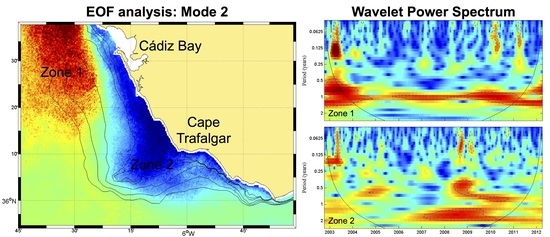High-Chlorophyll-Area Assessment Based on Remote Sensing Observations: The Case Study of Cape Trafalgar
Abstract
:1. Introduction
2. Data and Methodology
2.1. Satellite Images
2.2. Environmental Variables
2.3. Empirical Orthogonal Function (EOF) Analysis
2.4. Wavelet Analysis
3. Results
3.1. Spatial Variability
3.2. Temporal Variability
3.3. Chlorophyll Concentration Dynamics and Environmental Variables
4. Discussion
5. Conclusions
Acknowledgments
Author Contributions
Conflicts of Interest
Appendix A
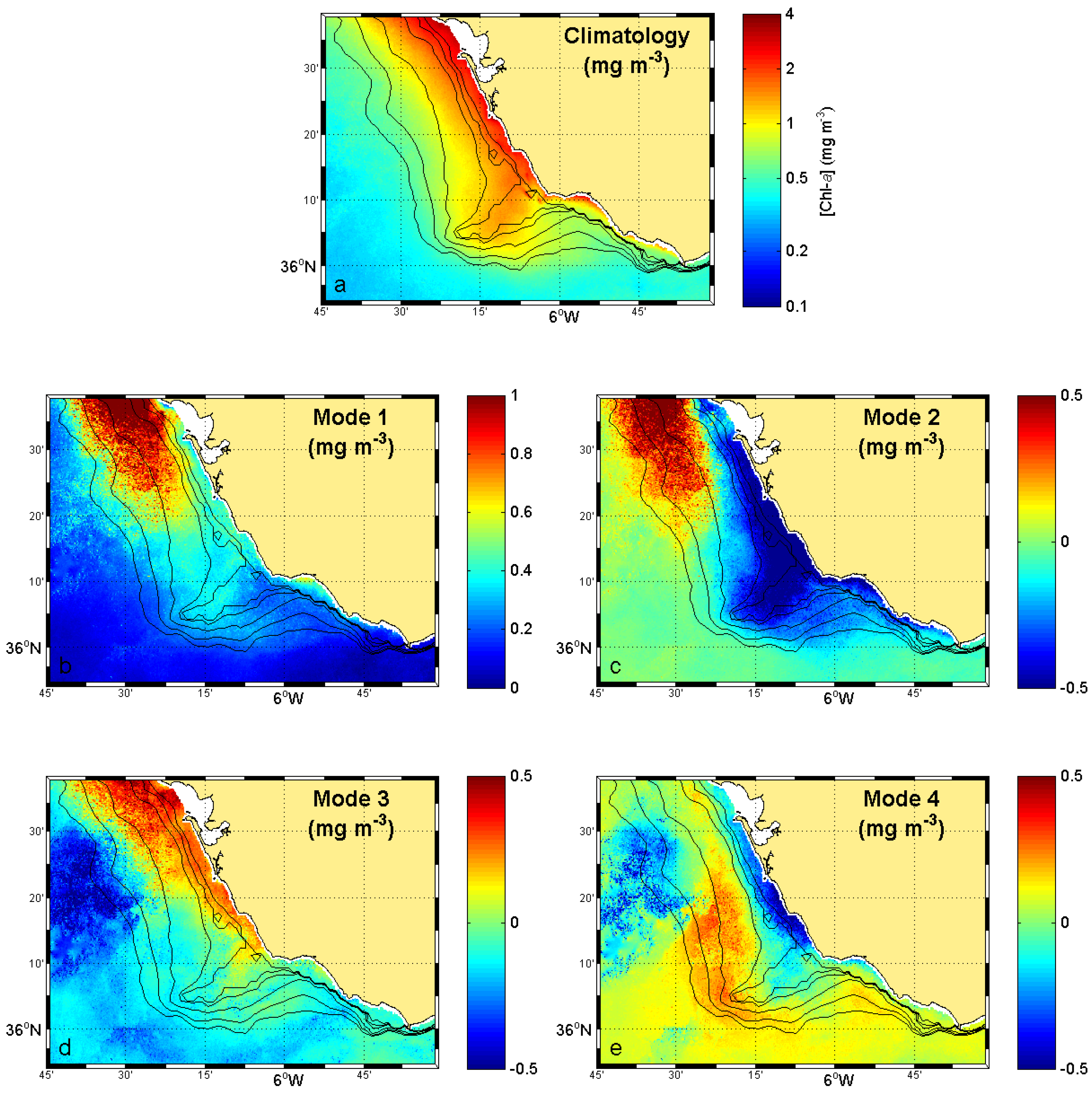
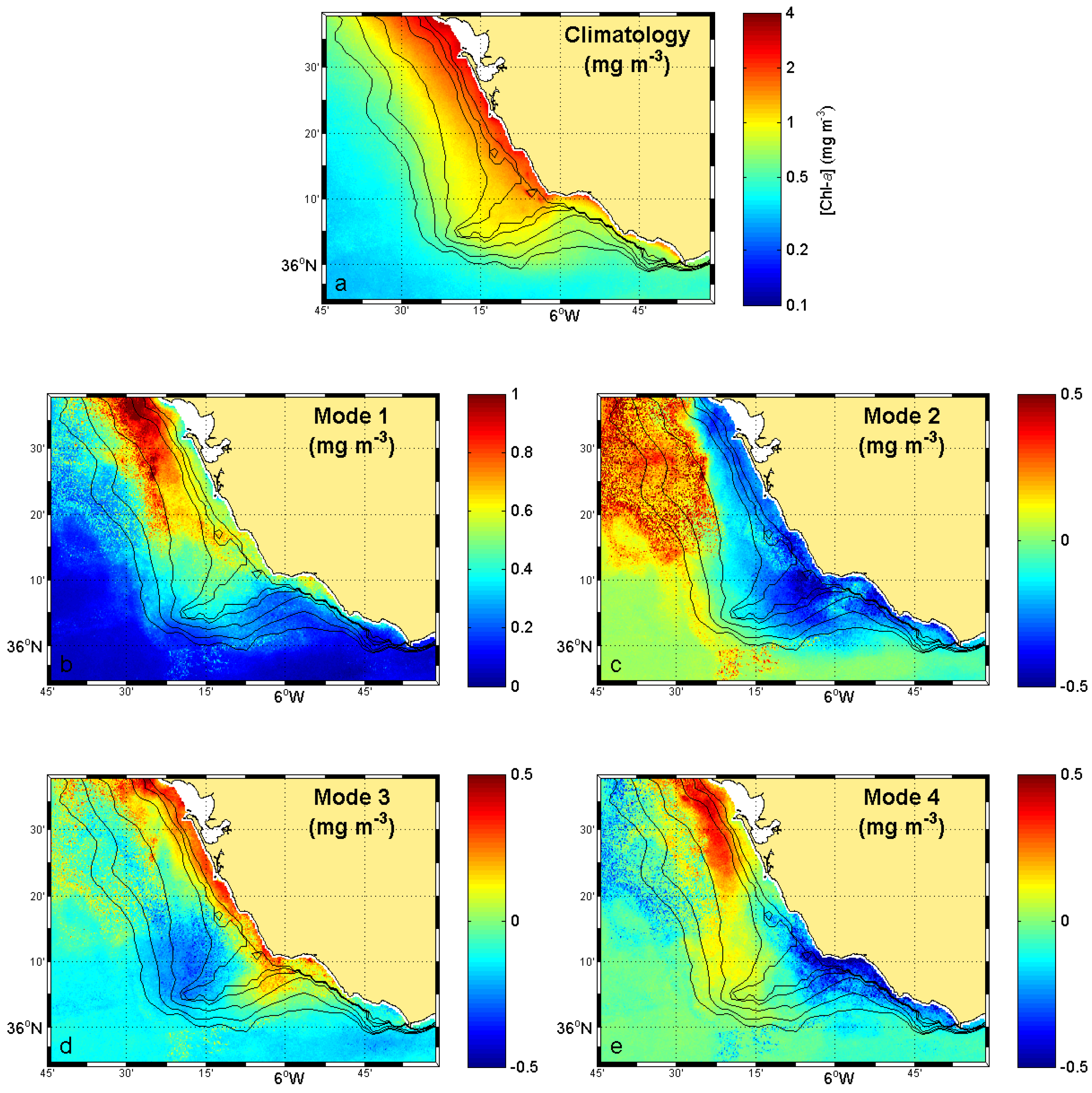
References
- Viúdez, A.; Haney, R.L. On the relative vorticity of the Atlantic jet in the Alborán Sea. J. Phys. Oceanogr. 1997, 27, 175–185. [Google Scholar] [CrossRef]
- La Violette, P.E.; Lacombe, H. Tidal-induced pulses in the flow through the Strait of Gibraltar. Oceanol. Acta 1988, 13–27. Available online: http://www.dtic.mil/dtic/tr/fulltext/u2/a207824.pdf (accessed on 7 December 2017).
- García-Lafuente, J.; Vargas, J.M.; Plaza, F.; Sarhan, T.; Candela, J.; Bascheck, B. Tide at the eastern section of the Strait of Gibraltar. J. Geophys. Res. 2000, 105, 14197–14213. [Google Scholar] [CrossRef] [Green Version]
- Bruno, M.; Alonso, J.J.; Cózar, A.; Vidal, J.; Ruiz-Cañavate, A.; Echevarría, F.; Ruiz, J. The boiling-water phenomena at Camarinal Sill, the Strait of Gibraltar. Deep Sea Res. Part II 2002, 49, 4097–4113. [Google Scholar] [CrossRef]
- Fernández, E.; Pingree, R.D. Coupling between physical and biological fields in the North Atlantic subtropical front southeast of the Azores. Deep Sea Res. Part I 1996, 43, 1369–1393. [Google Scholar] [CrossRef]
- Martins, C.S.; Hamann, M.; Fiúza, A.F. Surface circulation in the eastern North Atlantic, from drifters and altimetry. J. Geophys. Res. 2002, 107, 1–22. [Google Scholar] [CrossRef]
- Sala, I.; Caldeira, R.M.; Estrada-Allis, S.N.; Froufe, E.; Couvelard, X. Lagrangian transport pathways in the northeast Atlantic and their environmental impact. Limnol. Oceanogr. 2013, 3, 40–60. [Google Scholar] [CrossRef]
- Béthoux, J. Budgets of the Mediterranean Sea: Their dependence on the local climate and on the characteristics of the Atlantic waters. Oceanol. Acta 1979, 2, 157–163. [Google Scholar]
- Armi, L.; Farmer, D.M. The flow of Mediterranean water through the Strait of Gibraltar. Prog. Oceanogr. 1988, 21, 1–105. [Google Scholar]
- García-Lafuente, J.; Delgado, J.; Vargas, J.M.; Varela, M.; Plaza, F.; Sarhan, T. Low frequency variability of the exchanged flows through the Strait of Gibraltar during CANIGO. Deep Sea Res. Part II 2002, 49, 4051–4067. [Google Scholar] [CrossRef]
- Vargas, J.M.; García-Lafuente, J.; Delgado, F.C. Seasonal and wind-induced variability of Sea Surface Temperature patterns in the Gulf of Cádiz. J. Mar. Syst. 2003, 38, 205–219. [Google Scholar] [CrossRef]
- Macías, D.; García, C.M.; Echevarría, F.; Vázquez, A.; Bruno, M. Tidal induced variability of mixing processes on Camarinal Sill (Strait of Gibraltar): A pulsating event. J. Mar. Syst. 2006, 60, 177–192. [Google Scholar] [CrossRef]
- Vázquez, A.; Bruno, M.; Izquierdo, A.; Macías, D.; Ruiz-Cañavate, A. Meteorologically forced subinertial flows and internalwave generation at the main sill of the Strait of Gibraltar. Deep Sea Res. Part I 2008, 55, 1277–1283. [Google Scholar] [CrossRef]
- Bruno, M.; Chioua, J.; Romero, J.; Vázquez, A.; Macías, D.; Dastis, C.; Ramírez-Romero, E.; Echevarría, F.; Reyes, J.; García, C.M. The importance of submesoscale processes for the exchange of properties through the Strait of Gibraltar. Progr. Oceanogr. 2013, 116, 66–79. [Google Scholar] [CrossRef]
- García-Lafuente, J.; Sánchez-Román, A.; Díaz del Rí, G.; Sannino, G.; Sánchez-Garrido, J.C. Recent observations of seasonal variability of the Mediterranean outflow in the Strait of Gibraltar. J. Geophys. Res. 2007, 112, 1–11. [Google Scholar]
- Navarro, G.; Ruiz, J. Spatial and temporal variability of phytoplankton in the Gulf of Cádiz through remote sensing images. Deep Sea Res. Part II 2006, 53, 1241–1260. [Google Scholar] [CrossRef]
- García-Lafuente, J.; Ruiz, J. The Gulf of Cádiz pelagic ecosystem: A review. Progr. Oceanogr. 2007, 74, 228–251. [Google Scholar] [CrossRef]
- Bruno, M.; Macías, J.; González-Vida, J.M.; Vázquez, A. Analyzing the tidal-related origin of subinertial flows through the Strait of Gibraltar. J. Geophys. Res. 2010, 115, 1–13. [Google Scholar] [CrossRef]
- Macías, D.; Navarro, G.; Echevarría, F.; García, C.M.; Cueto, J. Phytoplankton pigment distribution in the northwestern Alborán Sea and meteorological forcing: A remote sensing study. J. Mar. Res. 2007, 65, 523–543. [Google Scholar] [CrossRef]
- Prieto, L.; García, C.M.; Corzo, A.; Segura, J.R.; Echevarría, F. Phytoplankton, bacterioplankton and nitrate reductase activity distribution in relation to physical structure in the northern Alborán Sea and Gulf of Cádiz (southern Iberian Peninsula). Boletin Instituto Espanol de Oceanografia 1999, 15, 401–411. [Google Scholar]
- Echevarría, F.; García-Lafuente, J.; Bruno, M.; Gorsky, G.; Goutx, M.; González, N.; García, C.M.; Gómez, F.; Vargas, J.M.; Picheral, M.; et al. Physical-biological coupling in the Strait of Gibraltar. Deep Sea Res. Part II 2002, 49, 4115–4130. [Google Scholar] [CrossRef]
- García, C.M.; Prieto, L.; Vargas, M.; Echevarría, F.; García-Lafuente, J.; Ruiz, J.; Rubín, J.P. Hydrodynamics and the spatial distribution of plankton and TEP in the Gulf of Cádiz (SW Iberian Peninsula). J. Plankton Res. 2002, 24, 817–833. [Google Scholar] [CrossRef]
- Lobo, F.; Hernández-Molina, F.; Somoza, L.; Rodero, J.; Maldonado, A.; Barnolas, A. Patterns of bottom current flow deduced from dune asymmetries over the Gulf of Cádiz shelf (southwest Spain). Mar. Geol. 2000, 164, 91–117. [Google Scholar] [CrossRef]
- Vargas-Yáñez, M.; Sarhan Viola, T.; Jorge, F.P.; Rubín, J.P.; García-Martínez, M.C. The influence of tide-topography interaction on low-frequency heat and nutrient fluxes. Application to Cape Trafalgar. Cont. Shelf Res. 2002, 22, 115–139. [Google Scholar] [CrossRef]
- Caballero, I. Estudio de Procesos en La Desembocadura del Guadalquivir y Golfo de Cádiz: Variabilidad Espacio-Temporal Mediante Teledetección. Ph.D. Thesis, University of Granada, Granada, Spain, 2015. [Google Scholar]
- Morel, A.; Antoine, D. Pigment Index Retrieval in Case 1 waters. MERIS Algorithm Theor. Basis Doc. 2000, 4, 9–25. [Google Scholar]
- Caballero, I.; Morris, E.P.; Prieto, L.; Navarro, G. The influence of the Guadalquivir River on spatio-temporal variability of suspended solid and chlorophyll in the eastern Gulf of Cádiz. Mediterr. Mar. Sci. 2014, 15, 721–738. [Google Scholar] [CrossRef]
- Navarro, G.; Ruiz, J.; Huertas, I.E.; García, C.M.; Criado-Aldeanueva, F.; Echevarría, F. Basin-scale structures governing the position of the deep fluorescence maximum in the Gulf of Cádiz. Deep Sea Res. Part II 2006, 53, 1261–1281. [Google Scholar] [CrossRef]
- Dee, D.; Uppala, S.; Simmons, A.; Berrisford, P.; Poli, P.; Kobayashi, S.; Andrae, U.; Balmaseda, M.; Balsamo, G.; Bauer, P.; et al. The ERA-Interim reanalysis: configuration and performance of the data assimilation system. Q. J. R. Meteorol. Soc. 2011, 137, 553–597. [Google Scholar] [CrossRef]
- Pawlowicz, R.; Beardsley, B.; Lentz, S. Classical tidal harmonic analysis including error estimates in MATLAB using T_TIDE. Comput. Geosci. 2002, 28, 929–937. [Google Scholar] [CrossRef]
- Obukhov, A. Statistically homogeneous fields on a sphere. Usp. Mat. Nauk 1947, 2, 196–198. [Google Scholar]
- Lorenz, E. Empirical orthogonal functions and statistical weather prediction. In Scientific Report No. 1, Statistical Forecasting Project; Department of Meteorology: Cambridge, MA, USA, 1956; Volume 1. [Google Scholar]
- Thomson, R.E.; Emery, W.J. Data Analysis Methods in Physical Oceanography; Elsevier: Amsterdam, The Netherlands, 1998. [Google Scholar]
- Kelly, K.A. Comment on “Empirical orthogonal function analysis of advanced very high resolution radiometer surface temperature patterns in Santa Barbara Channel” by G.S.E. Lagerloef and R.L. Bernstein. J. Geophys. Res. 1988, 93, 15753–15754. [Google Scholar] [CrossRef]
- North, G.R.; Bell, T.L.; Cahalan, R.F.; Moeng, F.J. Sampling errors in the estimation of empirical orthogonal functions. Mon. Weather Rev. 1982, 110, 699–706. [Google Scholar] [CrossRef]
- Cazelles, B.; Chavez, M.; Berteaux, D.; Ménard, F.; Vik, J.O.; Jenouvrier, S.; Stenseth, N.C. Wavelet analysis of ecological time series. Oecologia 2008, 156, 287–304. [Google Scholar] [CrossRef] [PubMed]
- Lau, K.M.; Weng, H. Climate signal detection using wavelet transform: How to make a time series sing. Bull. Am. Meteorol. Soc. 1995, 76, 2391–2402. [Google Scholar] [CrossRef]
- Torrence, C.; Compo, G.P. A practical guide to wavelet analysis. Bull. Am. Meteorol. Soc. 1998, 79, 61–78. [Google Scholar] [CrossRef]
- Klvana, I.; Berteaux, D.; Cazelles, B. Porcupine feeding scars and climatic data show ecosystem effects of the solar cycle. Am. Nat. 2004, 164, 283–297. [Google Scholar] [CrossRef] [PubMed]
- Ménard, F.; Marsac, F.; Bellier, E.; Cazelles, B. Climatic oscillations and tuna catch rates in the Indian Ocean: A wavelet approach to time series analysis. Fish. Oceanogr. 2007, 16, 95–104. [Google Scholar] [CrossRef]
- Keitt, T.H.; Fischer, J. Detection of scale-specific community dynamics using wavelets. Ecology 2006, 87, 2895–2904. [Google Scholar] [CrossRef]
- Buttay, L.; Cazelles, B.; Miranda, A.; Casas, G.; Nogueira, E.; González-Quirós, R. Environmental multi-scale effects on zooplankton inter-specific synchrony. Limnol. Oceanogr. 2017, 62, 1355–1365. [Google Scholar] [CrossRef]
- Grinsted, A.; Moore, J.; Jevrejeva, S. Application of the cross wavelet transform and wavelet coherence to geophysical time series. Nonlinear Process. Geophys. Eur. Geosci. Union 2004, 11, 561–566. [Google Scholar] [CrossRef]
- Cazelles, B.; Stone, L. Detection of imperfect population synchrony in an uncertain world. J. Anim. Ecol. 2003, 72, 953–968. [Google Scholar] [CrossRef]
- Franz, B.A.; Bailey, S.W.; Meister, G.; Werdell, P.J. Consistency of the NASA Ocean Color Data Record. In Proceedings of the Ocean Optics, Glasgow, UK, 8–12 October 2012. [Google Scholar]
- Kremer, J.; Nixon, S. A Coastal Marine Ecosystem: Simulation and Analysis; Springer: Berlin/Heidelberg, Germany, 1978. [Google Scholar]
- Ramírez-Romero, E.; Macías, D.; Bruno, M.; Reyes, E.; Navarro, G.; García, C.M. Submesoscale, tidally-induced biogeochemical patterns in the Strait of Gibraltar. Estuar. Coast. Shelf Sci. 2012, 101, 24–32. [Google Scholar] [CrossRef] [Green Version]
- Pingree, R.D.; Mardell, G.; Cartwright, D. Slope turbulence, internal waves and phytoplankton growth at the Celtic Sea shelf-break. Philos. Trans. R. Soc. Lond. A 1981, 302, 663–682. [Google Scholar] [CrossRef]
- New, A.; Pingree, R.D. Large-amplitude internal soliton packets in the central Bay of Biscay. Deep Sea Res. 1990, 37, 513–524. [Google Scholar] [CrossRef]
- Tee, K.; Smith, P.; LeFraive, D. Topographic upwelling off Southwest Nova Scotia. J. Phys. Oceanogr. 1993, 23, 1703–1726. [Google Scholar] [CrossRef]
- Pereira, A.; Belém, A.; Castro, B.M.; Geremias, R. Tide-topography interaction along the eastern Brazilian shelf. Cont. Shelf Res. 2005, 25, 1521–1539. [Google Scholar] [CrossRef]
- Vázquez, A.; Flecha, S.; Bruno, M.; Macías, D.; Navarro, G. Internal waves and short-scale distribution patterns of chlorophyll in the Strait of Gibraltar and Alborán Sea. Geophys. Res. Lett. 2009, 36. [Google Scholar] [CrossRef]
- Packard, T.T.; Minas, H.; Coste, B.; Martínez, R.; Bonin, M.; Gostan, J.; Garfield, P.; Christensen, J.; Dortch, Q.; Minas, M.; et al. Formation of the Alborán oxygen minimum zone. Deep Sea Res. 1988, 35, 1111–1118. [Google Scholar] [CrossRef]
- Minas, H.; Coste, B.; Le Corre, P.; Minas, M.; Raimbault, P. Biological and geochemical signatures associated with the water circulation through the Strait of Gibraltar and in the Western Alborán Sea. J. Geophys. Res. 1991, 96, 8755–8771. [Google Scholar] [CrossRef]
- Macías, D.; Martin, A.P.; García-Lafuente, J.; García, C.M.; Yool, A.; Bruno, M.; Vázquez, A.; Izquierdo, A.; Sein, D.V.; Echevarría, F. Analysis of mixing and biogeochemical tides on the Atlantic-Mediterranean effects induced by flow in the Strait of Gibraltar through a physical-biological coupled model. Prog. Oceanogr. 2007, 74, 252–272. [Google Scholar] [CrossRef]
- Lacombe, H.; Richez, C. The regime of the Strait of Gibraltar. In Elsevier Oceanography Series; Nihoul, J.C., Ed.; Elsevier: Amsterdam, The Netherlands, 1982; Volume 34, pp. 13–73. [Google Scholar]
- Hopkins, T.S. The thermohaline forcing of the Gibraltar exchange. J. Mar. Syst. 1999, 20, 1–31. [Google Scholar] [CrossRef]
- Fiúza, A.F.; de Macedo, M.; Guerreiro, M. Climatological space and time variation of the Portuguese coastal upwelling. Oceanol. Acta 1982, 5, 31–40. [Google Scholar]
- Fiúza, A.F.G. Upwelling Patterns off Portugal. In Coastal Upwelling Its Sediment Record; Suess, E., Thiede, J., Eds.; Springer: Boston, MA, USA, 1983; Volume 10B, pp. 85–98. [Google Scholar]
- Simpson, J.H.; Hunter, J.R. Fronts in the Irish Sea. Nature 1974, 250, 404–406. [Google Scholar] [CrossRef]
- Navarro, G.; Huertas, I.E.; Costas, E.; Flecha, S.; Díez-Minguito, M.; Caballero, I.; López-Rodas, V.; Prieto, L.; Ruiz, J. Use of a real-time remote monitoring network (RTRM) to characterize the Guadalquivir estuary (Spain). Sensors 2012, 12, 1398–1421. [Google Scholar] [CrossRef] [PubMed] [Green Version]
- Ruiz, J.; Polo, M.J.; Díez-Minguito, M.; Navarro, G.; Morris, E.P.; Huertas, I.E.; Caballero, I.; Contreras, E.; Losada, M.A. The Guadalquivir estuary: A hot spot for environmental and human conflicts. In Environmental Management and Governance; Finkl, C., Makowski, C., Eds.; Coastal Research Library Springer: Cham, Switzerland, 2015; Volume 8. [Google Scholar]
- Krug, L.A.; Platt, T.; Sathyendranath, S.; Barbosa, A.B. Unravelling region-specific environmental drivers of phytoplankton across a complex marine domain (off SW Iberia). Remote Sens. Environ. 2017, 203, 162–184. [Google Scholar] [CrossRef]
- Stanichny, S.; Tigny, V.; Stanichnaya, R.; Djenidi, S. Wind driven upwelling along the African coast of the Strait of Gibraltar. Geophys. Res. Lett. 2005, 32. [Google Scholar] [CrossRef]
- Criado-Aldeanueva, F.; García-Lafuente, J.; Vargas, J.M.; del Río, J.; Vázquez, A.; Reul, A.; Sánchez, A. Distribution and circulation of water masses in the Gulf of Cádiz from in situ observations. Deep Sea Res. Part II 2006, 53, 1144–1160. [Google Scholar] [CrossRef]
- Criado-Aldeanueva, F.; García-Lafuente, J.; Navarro, G.; Ruiz, J. Seasonal and interannual variability of the surface circulation in the eastern Gulf of Cádiz (SW Iberia). J. Geophys. Res. 2009, 114. [Google Scholar] [CrossRef]
- Pingree, R.D.; Mardell, G.; New, A. Propagation of internal tides from the upper slopes of the Bay of Biscay. Nature 1986, 321, 154–158. [Google Scholar] [CrossRef]
- Holligan, P.; Pingree, R.D.; Mardell, G. Oceanic solitons, nutrient pulses and phytoplankton growth. Nature 1985, 314, 348–350. [Google Scholar] [CrossRef]
- Lezama-Ochoa, A.; Irigoien, X.; Chaigneau, A.; Quiroz, Z.; Lebourges-Dhaussy, A.; Bertrand, A. Acoustics reveals the presence of a macrozooplankton biocline in the Bay of Biscay in response to hydrological conditions and predator-prey relationships. PLoS ONE 2014, 9, e88054. [Google Scholar] [CrossRef] [PubMed] [Green Version]
- Macías, D.; Bruno, M.; Echevarría, F.; Vázquez, A.; García, C.M. Meteorologically-induced mesoscale variability of the north-western Alborán Sea (southern Spain) and related biological patterns. Estuar. Coast. Shelf Sci. 2008, 78, 250–266. [Google Scholar] [CrossRef]
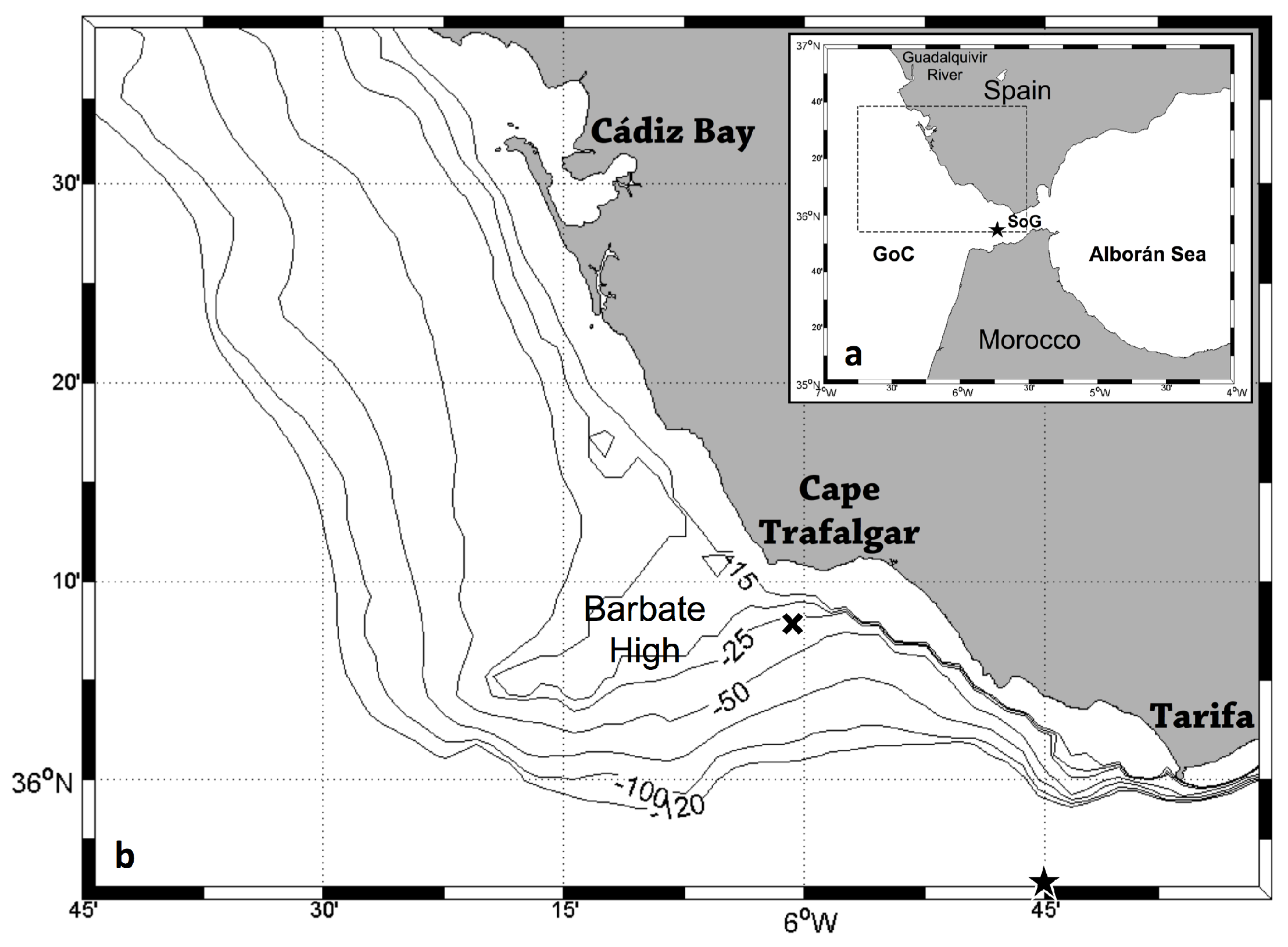
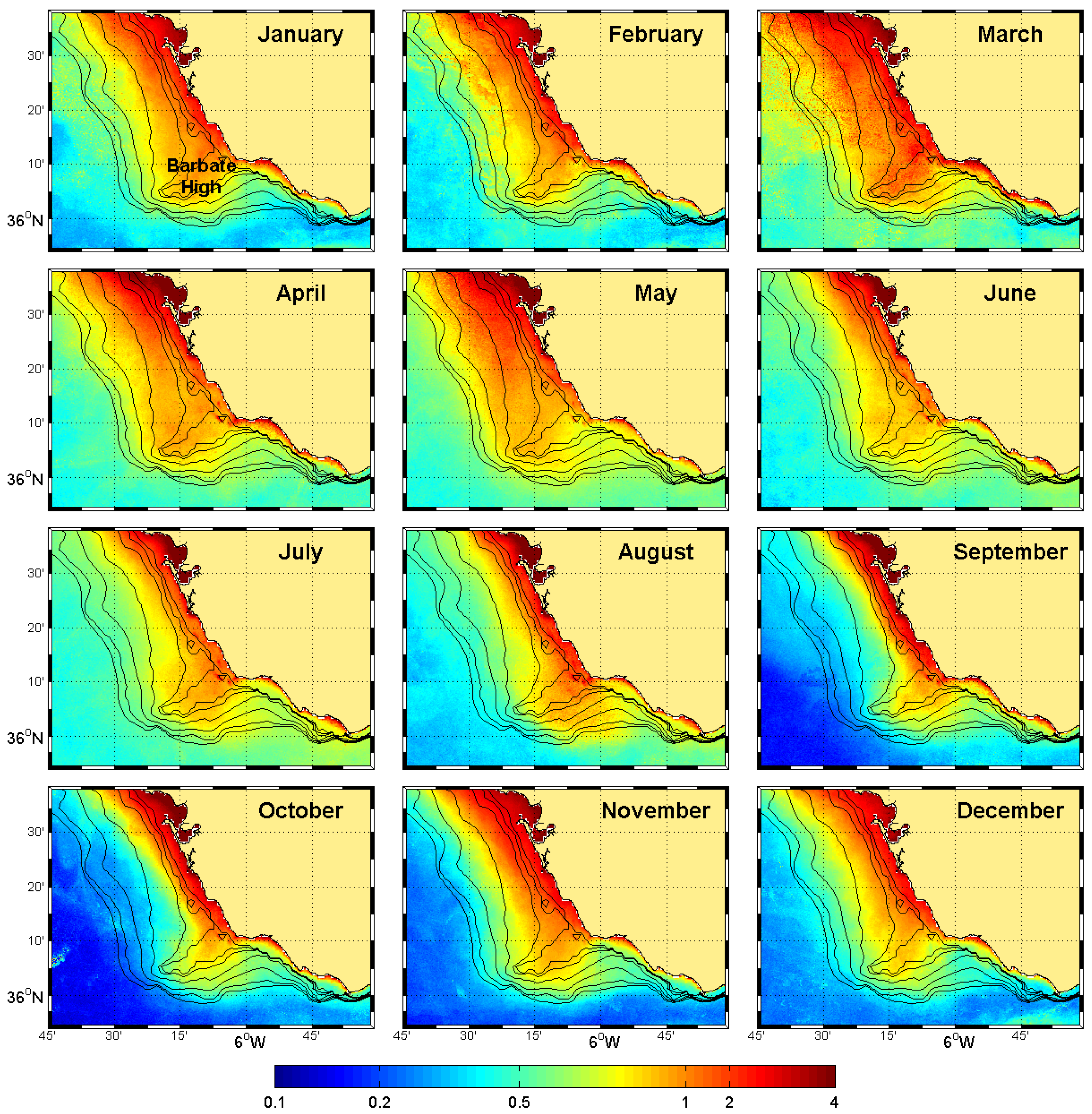
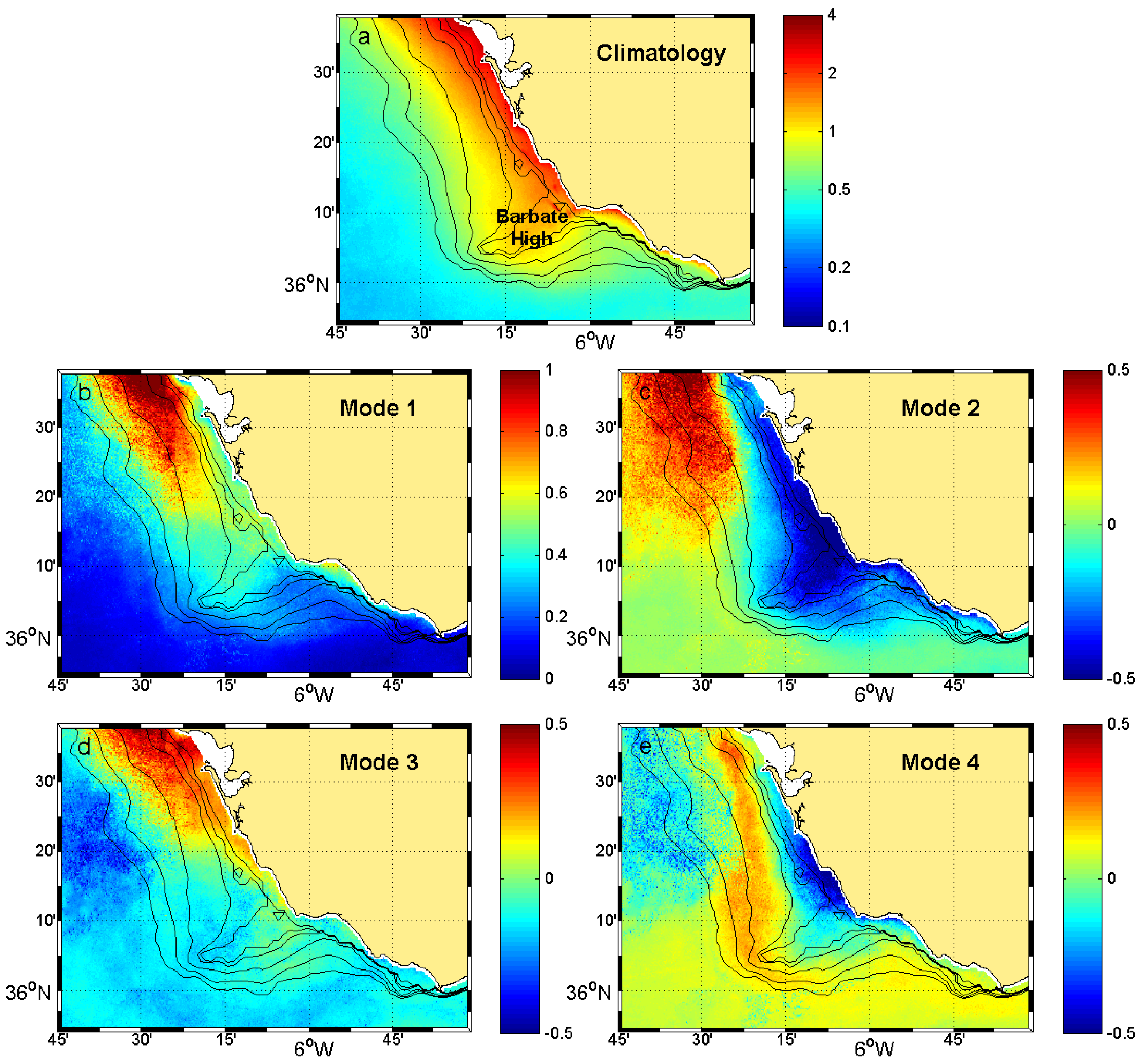
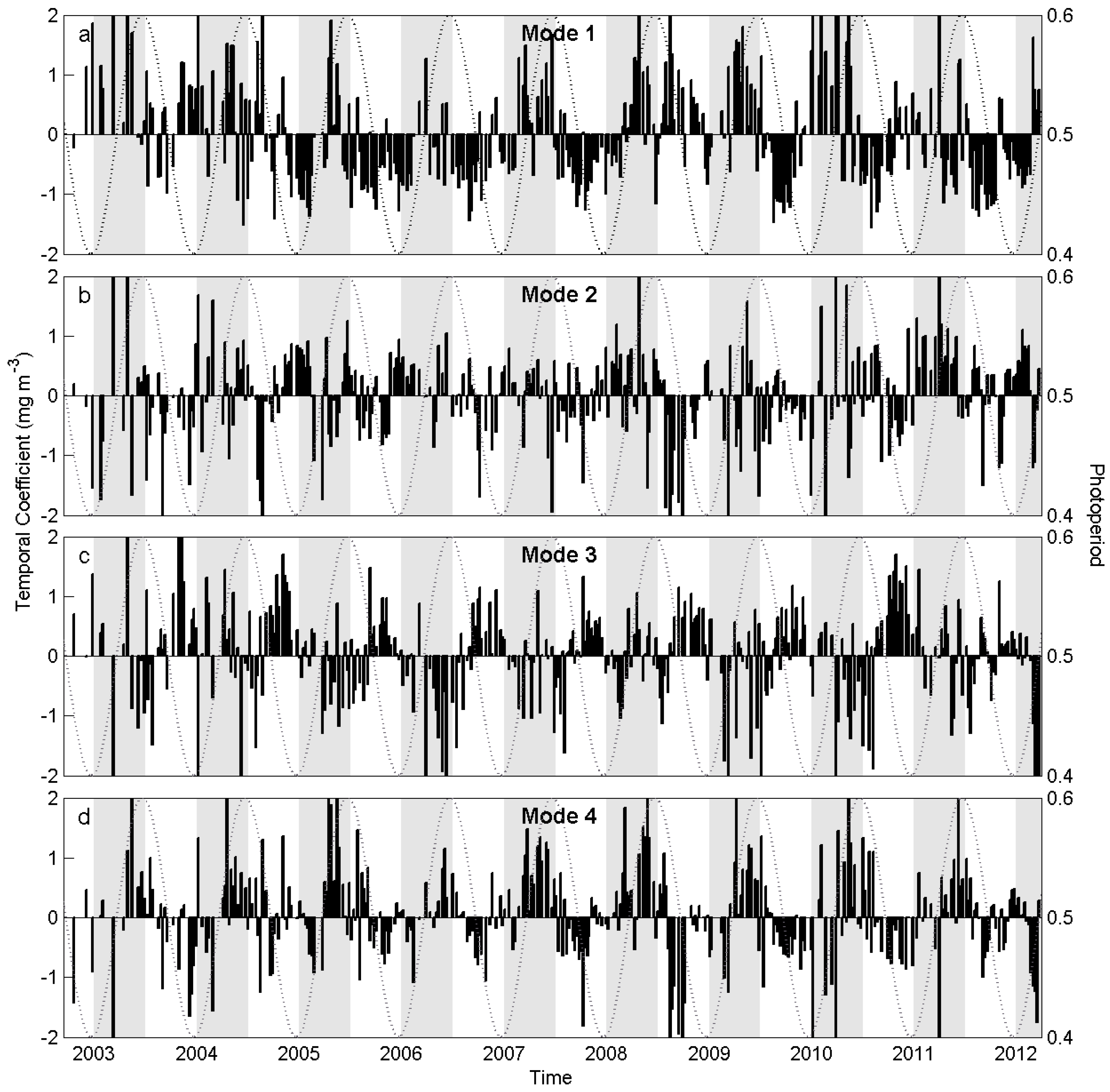
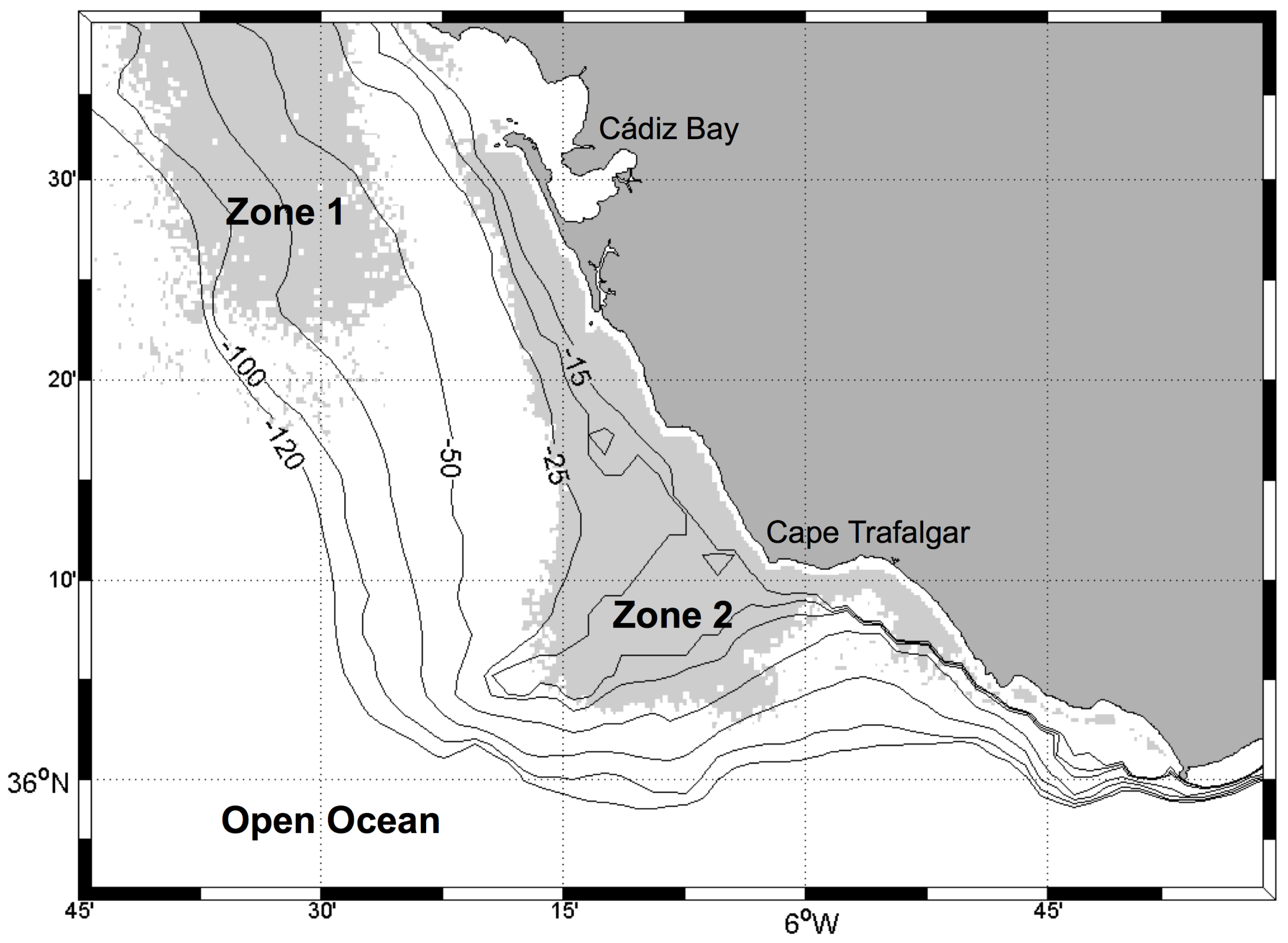
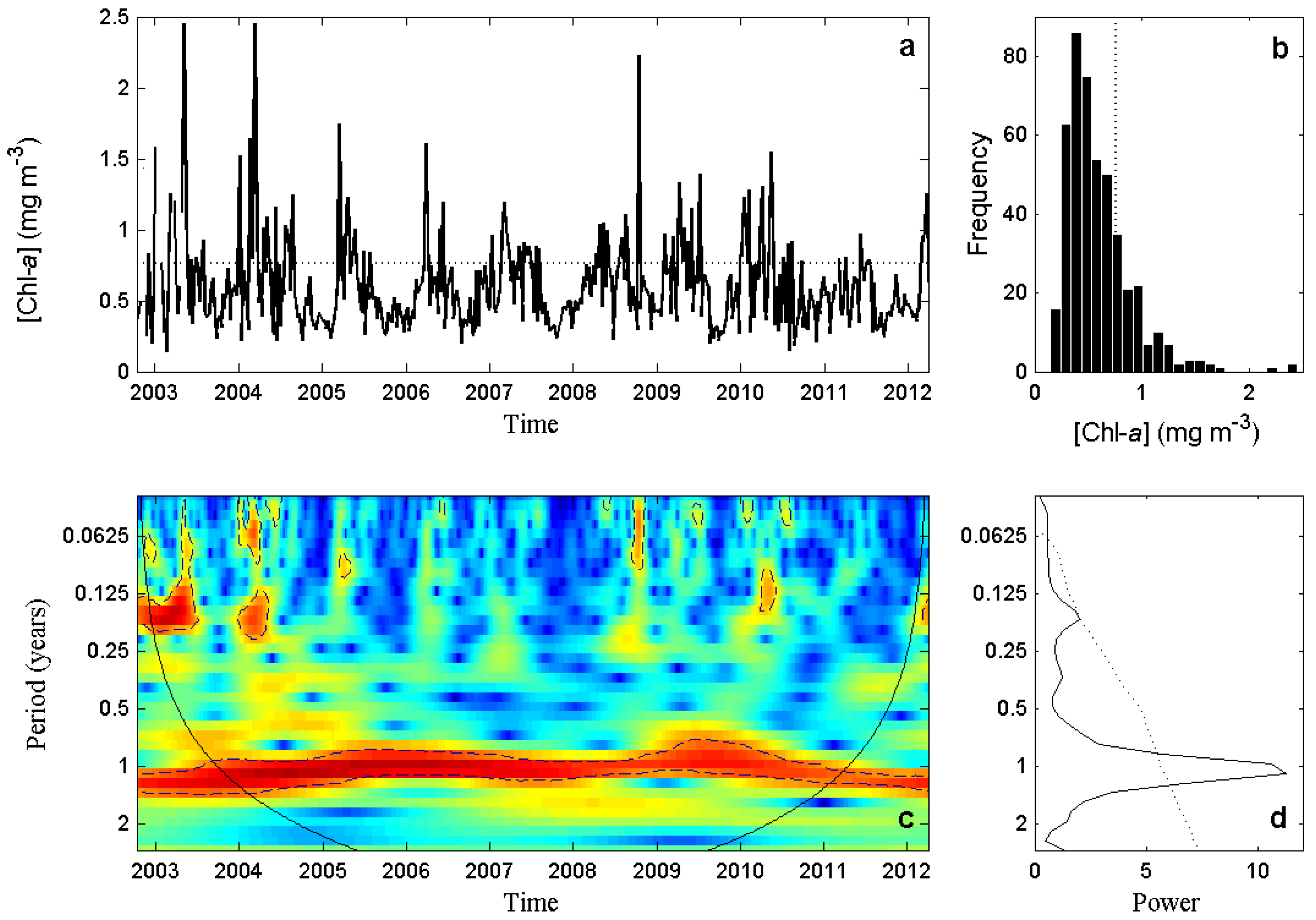
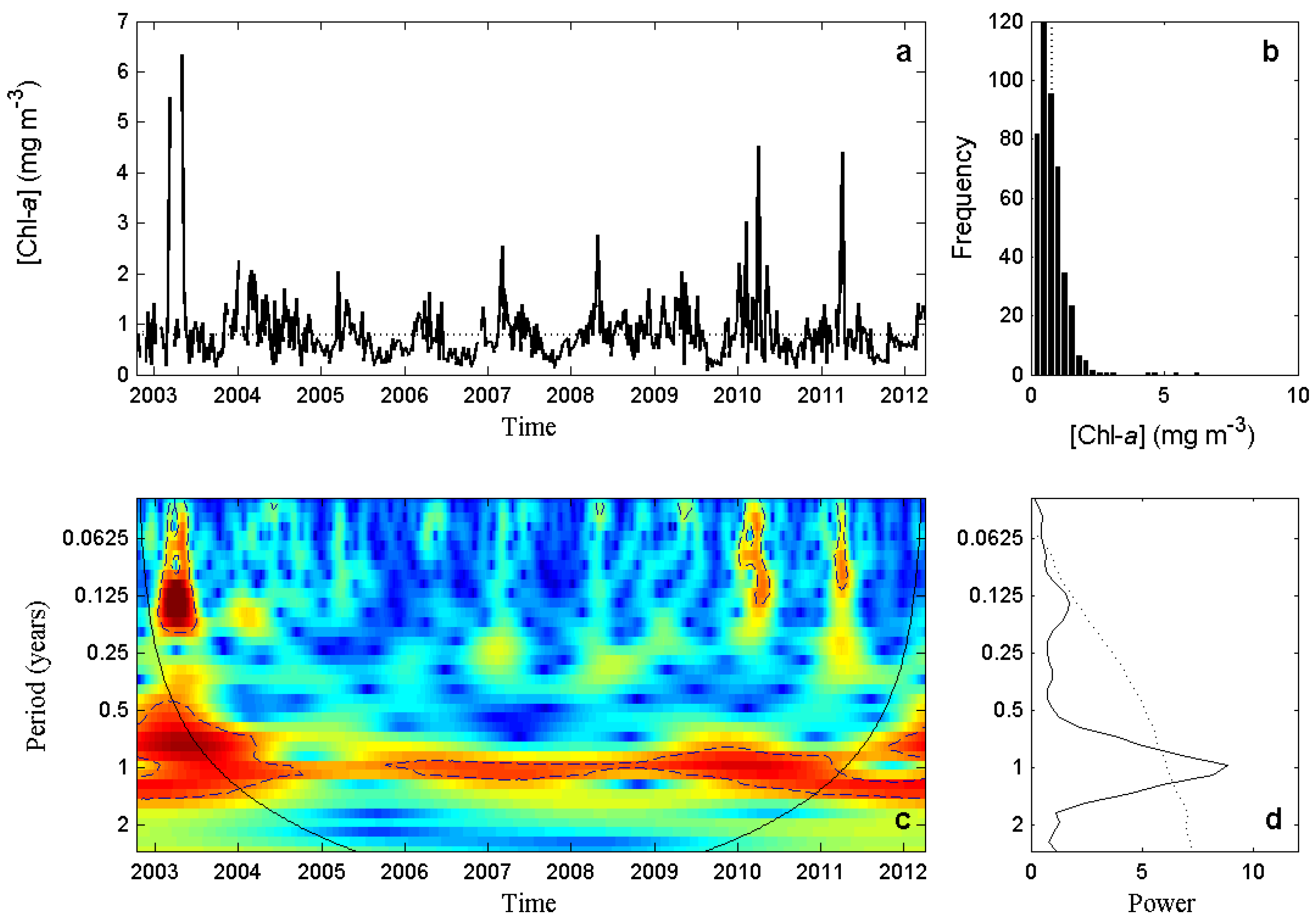

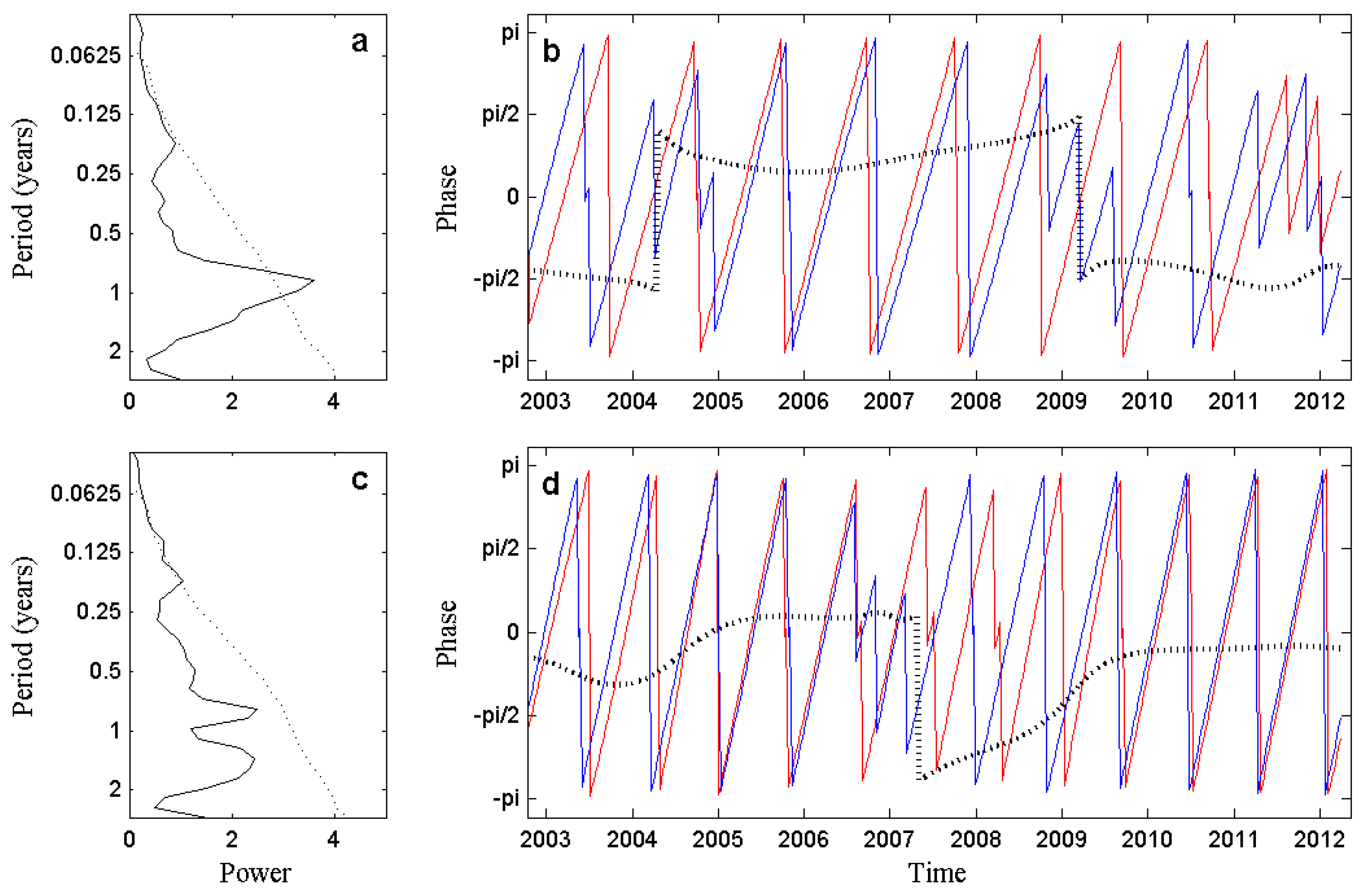
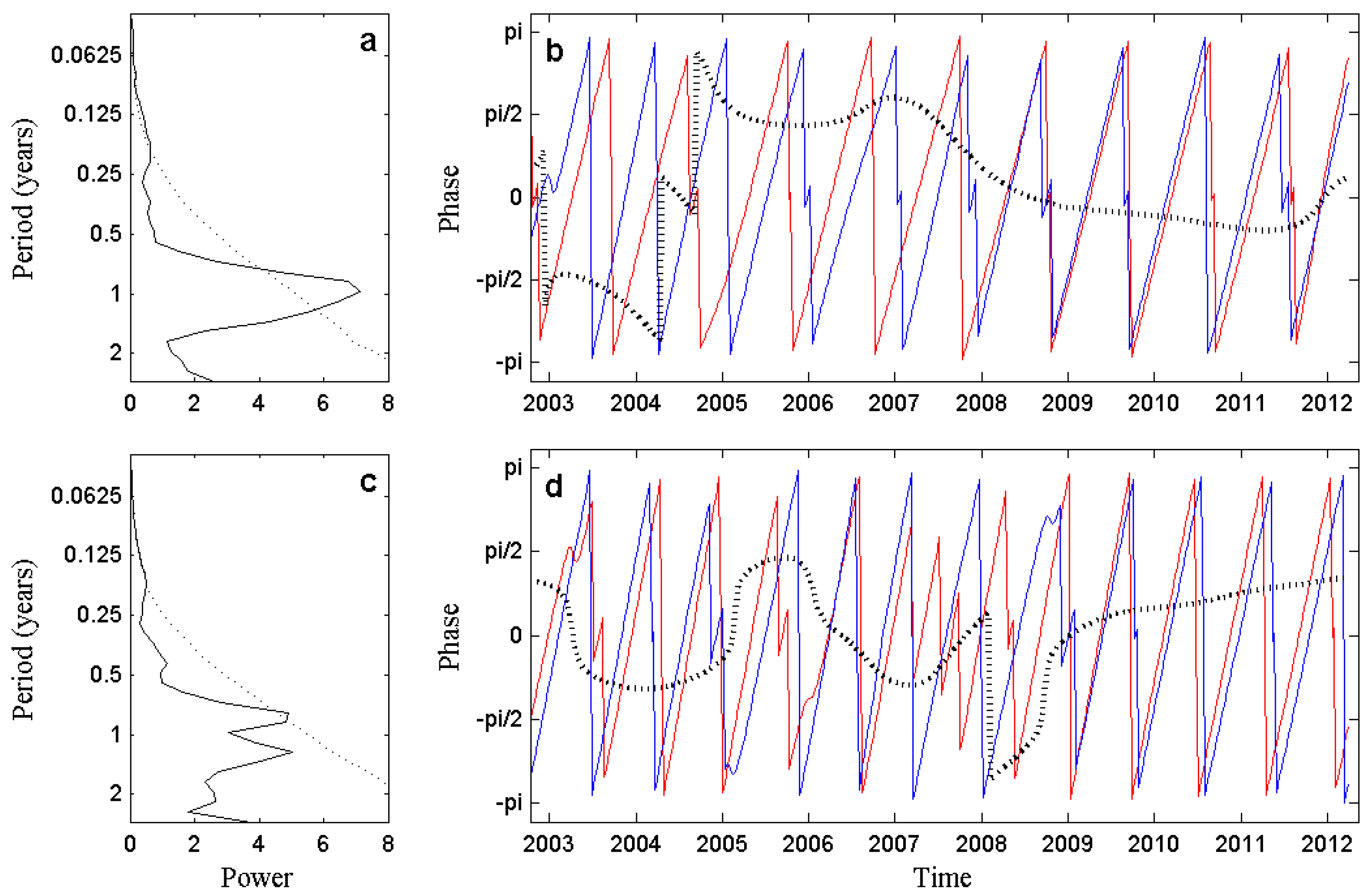

| Flag | Condition |
|---|---|
| LAND | Pixel is over land |
| CLOUD | Cloud contamination |
| ATMFAIL | Atmospheric correction failure |
| HIGLINT | High sun glint |
| HILT | Total radiance above knee |
| HISATZEN | Large satellite zenith |
| CLDICE | Cloud and/or ice |
| COCCOLITH | Coccolithophores detected |
| HISOLZEN | Large solar zenith |
| LOWLW | Very low water-leaving radiance |
| CHLFAIL | Chlorophyll algorithm failure |
| NAVWARN | Questionable navigation |
| MAXAERITER | Maximum iterations of NIR algorithm |
| CHLWARN | Chlorophyll out of range |
| ATMWARN | Atmospheric correction is suspect |
| Zonal Component of Wind | |||
| Cycle | Power | Total Variance | |
| Zone 1 | 1 year | ∼3.45 | ∼14.52% |
| Zone 2 | 10 months | ∼2.34 | ∼10.26% |
| Guadalquivir River Discharge | |||
| Cycle | Power | Total Variance | |
| Zone 1 | 1 year | ∼6.94 | ∼18.33% |
| Zone 2 | 10 months | ∼4.88 | ∼11.76% |
| Zonal Component of Tidal Current | |||
| Cycle | Power | Total Variance | |
| Zone 1 | 15 days | ∼10.31 | ∼45.11% |
| Zone 2 | 15 days | ∼5.99 | ∼35.59% |
© 2018 by the authors. Licensee MDPI, Basel, Switzerland. This article is an open access article distributed under the terms and conditions of the Creative Commons Attribution (CC BY) license (http://creativecommons.org/licenses/by/4.0/).
Share and Cite
Sala, I.; Navarro, G.; Bolado-Penagos, M.; Echevarría, F.; García, C.M. High-Chlorophyll-Area Assessment Based on Remote Sensing Observations: The Case Study of Cape Trafalgar. Remote Sens. 2018, 10, 165. https://doi.org/10.3390/rs10020165
Sala I, Navarro G, Bolado-Penagos M, Echevarría F, García CM. High-Chlorophyll-Area Assessment Based on Remote Sensing Observations: The Case Study of Cape Trafalgar. Remote Sensing. 2018; 10(2):165. https://doi.org/10.3390/rs10020165
Chicago/Turabian StyleSala, Iria, Gabriel Navarro, Marina Bolado-Penagos, Fidel Echevarría, and Carlos M. García. 2018. "High-Chlorophyll-Area Assessment Based on Remote Sensing Observations: The Case Study of Cape Trafalgar" Remote Sensing 10, no. 2: 165. https://doi.org/10.3390/rs10020165




